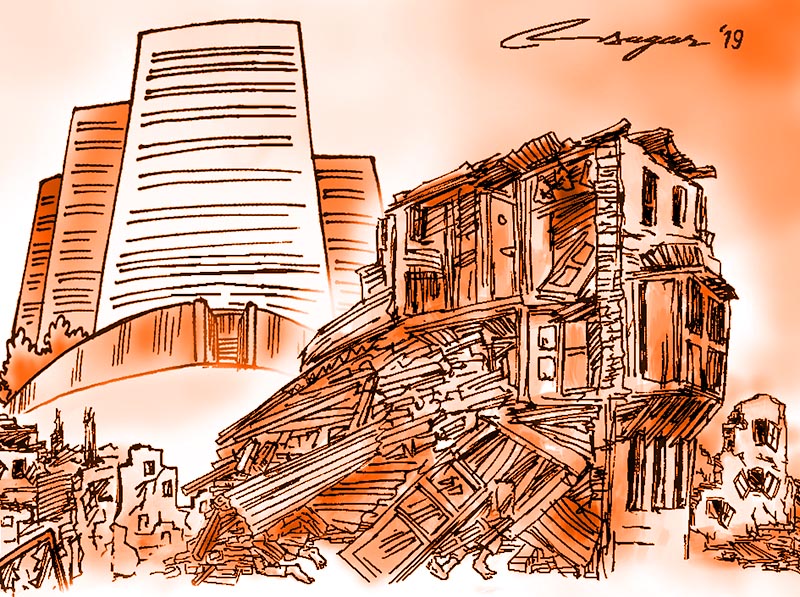Resilient reconstruction: Comply with building codes
The government and specifically the local authorities, must make a plan so that the trained people go and support the areas outside the earthquake-affected areas to make their buildings resilient
Nepal lies in a highly seismic hazard zone. Most of the casualties, deaths and injuries during an earthquake in Nepal are caused by collapsing buildings. A Global Earthquake Safety Initiative (GESI) research in Kathmandu had shown that about 85 per cent of the people killed by earthquakes were due to collapsed buildings. Thus, to reduce the potential casualties, the local governments must ensure compliance with the building code while giving permits.
There are today 293 urban municipalities and 460 rural municipalities with clear authority for urban planning, development and other activities, including building permit process. But there is a lack of trained human resources of different levels - engineers, architects or even construction technicians or masons. Even then, about 50 municipalities have started some initiative to ensure building code compliance with new construction. Making new buildings resilient is not difficult. But what to do with those that have already been built? To enhance their resilience, retrofitting is the best option. Retrofitting has been applied in schools. But for large-scale retrofitting, we do not have sufficient experience. And we have to understand that the process of both new construction and retrofitting is not only technical but also social, economic and cultural. In addition, the stakeholders involved are not only technical, but they also include businessmen selling materials, communities, teachers, students, the education system, homeowners, contractors, masons, engineers and architects.
In addition, a multipronged approach is required. Therefore, it is not only essential to develop the capacity of the technicians, similar capacity and awareness are needed in the different stakeholders. Based on earlier research and experience, it is possible to retrofit existing buildings even in rural areas. Many of the retrofitting techniques for different types of buildings are affordable, technically feasible, culturally acceptable, locally available and sustainable.
It is important to identify who provides the services that the people need. However, even if the people are aware and the capacity is there unless the local government has a system of building permits, compliance check in the submitted drawings and designs during construction, then it is difficult to ensure that the buildings will be resilient. The system should include registering of trained engineers, trained masons and also ensuring that all of the construction has at least one trained mason in place. Another method is to establish a system of monitoring houses under construction. For this, municipalities must start by formulating a plan to ensure building compliance, setting deadlines on training, creating awareness and disseminating information, and the system of creating different building permits or a building code section within the municipality.
The Nepal National Building Code has provisions for both urban and rural buildings to make them resilient. Even with little explanation, the general public can understand the most important parameters of resilient construction. For instance, in the case of stone or brick buildings, without reinforced concrete frames, the government has formulated 10 points. They include the shape, size, doors and windows, corners, bands, vertical rebars and others. These are the methods that ensure the resilience of both urban and rural buildings. In terms of retrofitting, there are methods which have been tested and implemented in Nepal.
In urban buildings, if the columns are not sufficient, they can be made bigger. If the beams are weak, they can be fixed. Thus, it is more about fixing and making things better. But retrofitting should not be misinterpreted as repair. Retrofitting is about making a building more resilient than its original form.
Following the Gorkha Earthquake, people have become aware of the need for resilient construction, and there are today trained masons in the community. But all the municipalities may not have a full system. Even after the reconstruction is over, any construction in those cities must be made resilient. To establish that system, registering trained masons and trained engineers, creating disaster risk management, implementing a building code implementation section in the municipality are important.
In the case of houses that were not fully damaged, they can be vulnerable, and so retrofitting them is crucial to make the whole city resilient. In developing countries, there is no guarantee that all houses will be 100 per cent code-compliant. But we have this opportunity now because most of the houses -- 70-80 per cent -- have been made resilient. We have many trained people in the earthquake-affected areas, but once the reconstruction is over, the number of houses to be constructed every year will significantly go down, especially in the next 15-20 years.
Hence, the government and specifically the local authorities must make a plan so that the trained people go and support the areas outside the earthquake-affected areas to make their buildings resilient. Once they have the skills for constructing resilient houses, it is very easy to supplement them with additional skills so that they can construct not only houses but also roads, retaining walls, bridges, schools and hospitals.
Guragain hold s a doctorate in Masonry Buildings






